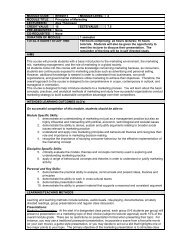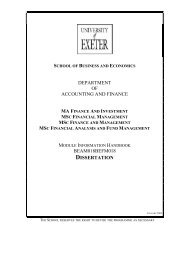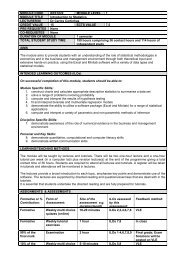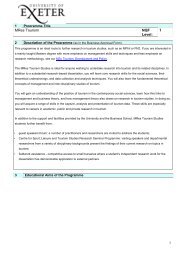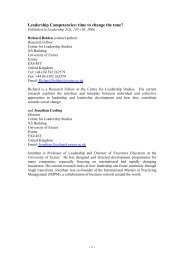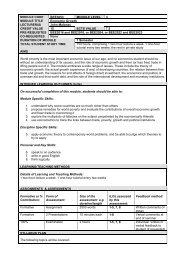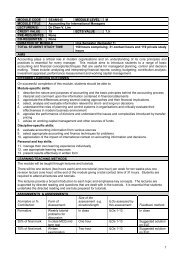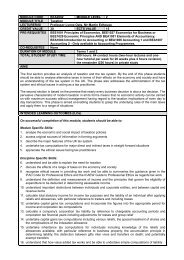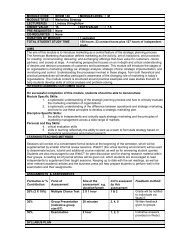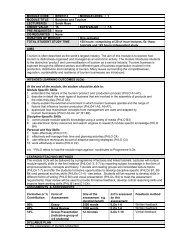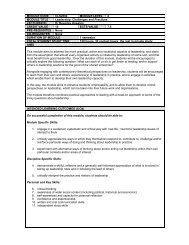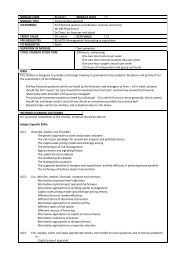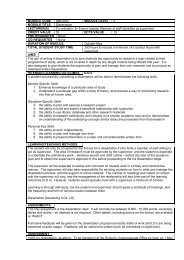Francesca Sanna-Randaccio paper - The Business School
Francesca Sanna-Randaccio paper - The Business School
Francesca Sanna-Randaccio paper - The Business School
You also want an ePaper? Increase the reach of your titles
YUMPU automatically turns print PDFs into web optimized ePapers that Google loves.
production and thus on the global level of emissions. 30 <strong>The</strong> job leakage, which is not explicitly<br />
considered in the welfare function, is indirectly captured by the change in the carbon tax revenue,<br />
as both phenomena depend on the fall in the domestic production level.<br />
6.1 <strong>The</strong> NR equilibrium outcome<br />
<strong>The</strong> unilateral mitigation measure, when firm 1 location strategy does not change, leads to<br />
a fall in world production and thus emissions, although part of the contraction in domestic<br />
production is compensated by a rise in foreign output. In fact we have:<br />
ˆ NR ~ t <br />
I t II t I t II<br />
( Q W QW<br />
) <br />
0<br />
(20)<br />
3bI<br />
3bII<br />
<br />
In this scenario, the impact of the unilateral policy on consumers’ aggregate welfare is<br />
positive. Consumers’ aggregate welfare (see Cole et al. 2009, p. 1242) is given by the sum of<br />
consumers’ surplus and pollution tax revenues, less the damage from pollution. Here we assume<br />
that the revenue of the pollution tax is 100% returned to the taxpayers. 31 Although consumers’<br />
surplus narrowly defined falls, for sufficiently low values of t II , the carbon tax revenue increase<br />
is greater than the fall in consumers’ surplus, since under rather general conditions (see Appendix<br />
C):<br />
( CSˆ<br />
NR<br />
I<br />
~ ˆ NR ~<br />
CS<br />
I ) ( TI<br />
TI<br />
) <br />
t I t II 2AI<br />
11t<br />
I 3t<br />
II 8s<br />
6(<br />
AII<br />
<br />
<br />
6 3bI<br />
2t<br />
2 ) <br />
I t II s<br />
0<br />
3bII<br />
<br />
Furthermore, pollution damage decreases since (see Appendix C):<br />
( Dˆ<br />
NR<br />
I<br />
~<br />
D ) <br />
I<br />
1 1 4 3 2 4 3 2 <br />
I<br />
AI<br />
tI<br />
tII<br />
s AII<br />
tI<br />
tII<br />
s<br />
(22)<br />
( tI<br />
tII<br />
)( ) <br />
<br />
0<br />
6 bI<br />
bII<br />
3bI<br />
3bII<br />
<br />
<strong>The</strong> local firm’s profits instead diminish in both markets, as<br />
NR ~ 4 ( A ) ( 2 ) <br />
I t I s AII<br />
t I s<br />
ˆ 1 ) ( t I t II ) <br />
<br />
0<br />
(23)<br />
9 bI<br />
bII<br />
<br />
( 1<br />
<strong>The</strong> previous results allow us to state that:<br />
(21)<br />
18



